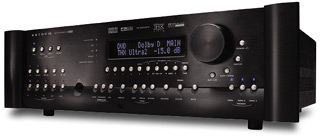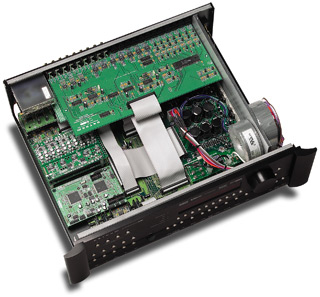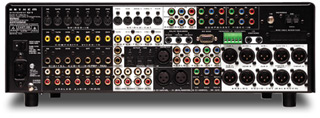![[SoundStage!]](../sslogo3.gif) Getting Technical Getting TechnicalBack-Issue Article |
August 2004 Anthem's Statement D1 Preamplifier/Processor: An Interview with Anthem's Nick Platsis
But while new technology may bring the benefit of affordable prices, the increasing number of format options has challenged today’s multichannel-sound aficionados. For example: DVD-Video (DVD-V), DVD-Audio (DVD-A), Super Audio CD (SACD), and Digital Theater Sound (DTS) all share the generic DVD platform; however, not all players can handle all of these formats. Early-model DVD-Video players could not play DVD-Audio. And very few DVD-Video players today, for example, can play SACDs. For the consumer, then, keeping up with the technology can be daunting, confusing, and expensive. Modern-day preamplifier/surround-sound processors (pre/pros) are therefore complex machines. Not only must they process a variety of inputs from these various formats, distortion must be diminished, sound quality must be optimized, and functionality that allows the consumer complete control over the sound produced must be in place. One of today's most advanced pre/pros is the next generation of Anthem's popular AVM 20, the Anthem Statement D1. I spoke with the product developer of the D1, Nick Platsis, who has been in the audio industry for 15 years, half of them at Sonic Frontiers, the developers of Anthem products. He has been crazy about sound since the age of eight when he was sorely disappointed with the sound quality of his father's new stereo compared to that of the system it replaced. Henceforth, his obsession with sound quality developed into his livelihood. Though Anthem began as a bang-for-the-buck line of two-channel products put out by Sonic Frontiers, purchase by Paradigm focused the company onto home theater and led to the development of the popular AVM 20 surround-sound processor. "Which," says Platsis, "many have said to be the best multichannel pre/pro in its price class and beyond." Home Theater & Sound, our sister publication, named the AVM 20 Product of the Year for 2002. The new Statement D1's functionality, though, is far more advanced than that of the AVM 20 and can be described simply as "upsampling everywhere." The D1 also has features that will appeal not just to home-theater enthusiasts, but to audiophiles, particularly those immersed in multichannel music.
For some it all sounds too good to be true. For audio purists, though, the fact that the D1 converts the high-resolution DVD-A and SACD analog streams to digital and then back to analog will likely drive them crazy. Why the additional conversion? Once is enough, most believe, and further processing only degrades the sound. Platsis contends that audiophiles simply need to set aside their initial phobia and skepticism and experience the difference in sound quality before laying judgment. "In the case of the D1, the measured differences between 'DSP mode' and 'direct mode' show that [distortion] is all below the limits of human audibility. No one has ever found any difference through a listening test even with the D1 when it is switched in and out of DSP mode." "The reason A-to-D conversion is there in the first place on the six-channel input," continues Platsis, "is because early on we really didn't think that everyone would actually use five equally spaced full-range speakers with [DVD-A and SACD source material], and FireWire was nowhere near becoming a reality. The AVM 20 was the first processor to do this, and it's in the Statement D1 because the combination players out there with FireWire are still in the minority." FireWire is a type of cabling technology for transferring data to and from digital devices at high speed. Apple Computer invented FireWire, also known as IEEE 1394. The development of digital video, digital cameras, and other multimedia devices has made FireWire indispensable. It provides a high-speed digital connection that easily and quickly sends large amounts of information to PCs. Platsis explains that making FireWire a reality is more complicated than most realize. "There's more than one way of getting the same job done within FireWire, and some consumers in the world of audio have taken the phrase 'IEEE standard' as meaning that there's only one way of making a digital player talk to a receiver or pre/pro."
"It's not just about DVD-A or multichannel SACD, though; video games are everywhere, and soundcards with multichannel output are gaining ground," continues Platsis. "Also, when turning a two-channel analog input signal into surround through AnthemLogic, Pro Logic, Neo:6, etc., there's no choice but to convert it to digital." The D1 is also the first pre/pro to upsample Dolby Digital and DTS, and some may be surprised that these lower-resolution movie formats would be included in its design. The improvement in sound quality through the D1’s digital processing for these formats, though, will more than likely be a welcome addition. "Without Dolby and DTS, a multichannel preamp isn't very useful," explains Platsis. "When they're decoded, they're pulse-code modulated (PCMed), up to eight channels worth. The upsampler is at the output of the DSP, so it's just a matter of putting all the signals on the very same path. At this stage they're all PCM anyway and get the same benefits from upsampling. In simple terms, the often-misunderstood job of the reconstruction filter is to replicate the original signal by forcing the output curve to have a shape exactly like the original's. Digital-to-analog conversion is not a matter of connecting individual samples with straight lines or stair steps." Technology is forever evolving, and what eventually captures the consumer market is impossible to guess. So the future of the Statement D1 depends on consumer demand. "When the AVM 20 was out," says Platsis, "people were asking for a signature or special-edition version, but we had already gotten everything we could out of the AVM 20, so something different had to be done to put the D1 above. The concept of keeping the D1 current through free software downloads and reasonably priced hardware upgrades still applies. Still, although the D1 is now out, the AVM 20 is not anywhere near the end of the cycle -- significant changes are still coming over the next year: HDMI, FireWire, video transcoding. However, the D1 will probably get them first, and then the AVM 20 will follow." Years ago skeptics believed that home surround sound would never become as popular as stereo because of the inconvenience of six loudspeakers. With a pre/pro like the Statement D1 ensuring proper speaker set up, and offering a multitude of features and upgradeability, audiophiles are guaranteed the best performance from whatever format they choose now and for the foreseeable future. ...Alison Aulph Read more about the Anthem Statement D1 on our sister publication, Home Theater & Sound.
|
|
![[SoundStage!]](../sslogo3.gif) All Contents All ContentsCopyright © 2004 SoundStage! All Rights Reserved |
 Technology advances
at an incredible rate. When surround sound was invented for Disney's Fantasia, the
film had to travel with its own sound system and sound team because no cinema was capable
of reproducing the effect. In just 60 years, "Fantasound" has developed into
multichannel systems so affordable that home theater is not just a reality, it's
commonplace.
Technology advances
at an incredible rate. When surround sound was invented for Disney's Fantasia, the
film had to travel with its own sound system and sound team because no cinema was capable
of reproducing the effect. In just 60 years, "Fantasound" has developed into
multichannel systems so affordable that home theater is not just a reality, it's
commonplace. The D1 has multiple converters that upsample every
input channel, whether digital or analog, to 192kHz. This includes CD, DVD-A, SACD, Dolby
Digital, and DTS. The digital-to-analog converters (DACs) then oversample the signal by a
factor of 128 times to raise the final sample rate to 24.576MHz. (For a complete
explanation of oversampling and upsampling, please refer to my November 2003 article:
The D1 has multiple converters that upsample every
input channel, whether digital or analog, to 192kHz. This includes CD, DVD-A, SACD, Dolby
Digital, and DTS. The digital-to-analog converters (DACs) then oversample the signal by a
factor of 128 times to raise the final sample rate to 24.576MHz. (For a complete
explanation of oversampling and upsampling, please refer to my November 2003 article:  But even without
FireWire, you can use any SACD or DVD-A player on the six-channel analog input, where the
incoming analog signal is converted to digital and upsampled. Doing this with the D1
ensures that the loudspeaker system can be properly set up through DSP sound management.
Owners of DVD-A and SACD source material and players can now benefit from the bass
management, time alignment, bass/treble controls, THX post-processing, audio group delay,
and two-channel downmix for multichannel material that the D1 provides.
But even without
FireWire, you can use any SACD or DVD-A player on the six-channel analog input, where the
incoming analog signal is converted to digital and upsampled. Doing this with the D1
ensures that the loudspeaker system can be properly set up through DSP sound management.
Owners of DVD-A and SACD source material and players can now benefit from the bass
management, time alignment, bass/treble controls, THX post-processing, audio group delay,
and two-channel downmix for multichannel material that the D1 provides.